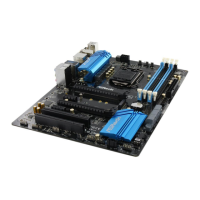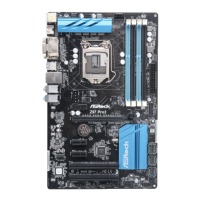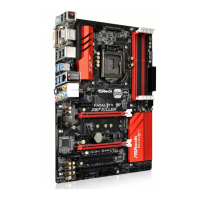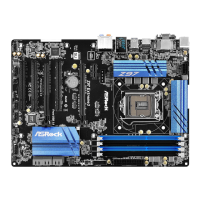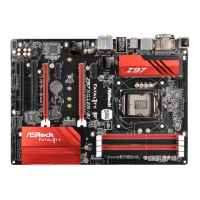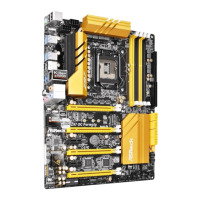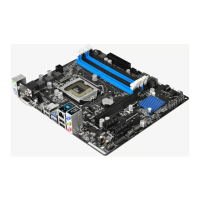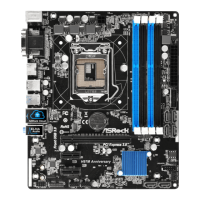Do you have a question about the ASROCK Z97 Anniversary and is the answer not in the manual?
Lists all items included in the motherboard package.
Details the technical specifications of the motherboard, including CPU, memory, and expansion slots.
Visual diagram identifying the location of key components and connectors on the motherboard.
Describes the external input/output ports and their functions.
Essential safety and handling guidelines before installing motherboard components.
Step-by-step guide for safely installing the central processing unit onto the motherboard socket.
Instructions for mounting the CPU cooler assembly onto the processor and motherboard.
Guide on correctly inserting RAM modules into the motherboard slots for optimal dual-channel performance.
Explains the types and uses of PCI and PCI Express slots for adding expansion cards.
Details the function and configuration of motherboard jumpers, such as the Clear CMOS jumper.
Identifies and explains the purpose of various internal headers and connectors on the motherboard.
Instructions for installing essential drivers and utilities from the support CD for system functionality.
Guide to ASRock's multi-purpose software suite for system monitoring, tuning, and fan control.
Setup and configuration for Intel's feature enabling faster system wake-up from sleep modes.
How to use Intel's feature to automatically update applications while the computer is in sleep mode.
Information on connecting mobile devices and remotely controlling the PC via ASRock Cloud services.
Guide to using the online store for downloading ASRock applications, drivers, and utilities.
Instructions for installing and configuring Start8 to restore the Windows Start Menu functionality.
Overview of the UEFI SETUP UTILITY, how to enter it, and general information.
Explains the selections available in the UEFI setup utility's top menu bar.
Details the keyboard shortcuts and mouse controls used to navigate the UEFI setup interface.
Description of the system overview displayed on the UEFI Main screen upon entry.
Guide to configuring overclocking settings, CPU ratios, voltages, and memory timings.
Covers configurations for CPU, Chipset, Storage, and other advanced system settings.
Detailed settings for CPU features, core control, power saving, and virtualization.
Settings related to the motherboard chipset, including graphics adapter and I/O configurations.
Options for managing SATA controllers, modes (IDE, AHCI, RAID), and disk reliability monitoring.
Configuration of Intel's Rapid Start Technology within the UEFI BIOS settings.
Configuration of Intel's Smart Connect Technology within the UEFI BIOS settings.
Settings for Super I/O components like PS/2 ports, Serial ports, and their addresses.
Power management settings related to ACPI, including sleep states and wake-up events.
Settings for enabling/disabling USB controllers, USB 3.0 modes, and legacy support.
Configuration for BIOS support of security devices and Trusted Computing features.
Access to system browser, utilities like OMG, RAID/driver installers, and BIOS flashing tools.
Displays system hardware status including temperatures, fan speeds, and voltages.
Settings for boot order, fast boot options, LAN boot, and CSM compatibility.
Options for setting supervisor/user passwords and configuring Secure Boot.
Options for saving changes, discarding changes, loading defaults, and launching EFI Shell.
Lists all items included in the motherboard package.
Details the technical specifications of the motherboard, including CPU, memory, and expansion slots.
Visual diagram identifying the location of key components and connectors on the motherboard.
Describes the external input/output ports and their functions.
Essential safety and handling guidelines before installing motherboard components.
Step-by-step guide for safely installing the central processing unit onto the motherboard socket.
Instructions for mounting the CPU cooler assembly onto the processor and motherboard.
Guide on correctly inserting RAM modules into the motherboard slots for optimal dual-channel performance.
Explains the types and uses of PCI and PCI Express slots for adding expansion cards.
Details the function and configuration of motherboard jumpers, such as the Clear CMOS jumper.
Identifies and explains the purpose of various internal headers and connectors on the motherboard.
Instructions for installing essential drivers and utilities from the support CD for system functionality.
Guide to ASRock's multi-purpose software suite for system monitoring, tuning, and fan control.
Setup and configuration for Intel's feature enabling faster system wake-up from sleep modes.
How to use Intel's feature to automatically update applications while the computer is in sleep mode.
Information on connecting mobile devices and remotely controlling the PC via ASRock Cloud services.
Guide to using the online store for downloading ASRock applications, drivers, and utilities.
Instructions for installing and configuring Start8 to restore the Windows Start Menu functionality.
Overview of the UEFI SETUP UTILITY, how to enter it, and general information.
Explains the selections available in the UEFI setup utility's top menu bar.
Details the keyboard shortcuts and mouse controls used to navigate the UEFI setup interface.
Description of the system overview displayed on the UEFI Main screen upon entry.
Guide to configuring overclocking settings, CPU ratios, voltages, and memory timings.
Covers configurations for CPU, Chipset, Storage, and other advanced system settings.
Detailed settings for CPU features, core control, power saving, and virtualization.
Settings related to the motherboard chipset, including graphics adapter and I/O configurations.
Options for managing SATA controllers, modes (IDE, AHCI, RAID), and disk reliability monitoring.
Configuration of Intel's Rapid Start Technology within the UEFI BIOS settings.
Configuration of Intel's Smart Connect Technology within the UEFI BIOS settings.
Settings for Super I/O components like PS/2 ports, Serial ports, and their addresses.
Power management settings related to ACPI, including sleep states and wake-up events.
Settings for enabling/disabling USB controllers, USB 3.0 modes, and legacy support.
Configuration for BIOS support of security devices and Trusted Computing features.
Access to system browser, utilities like OMG, RAID/driver installers, and BIOS flashing tools.
Displays system hardware status including temperatures, fan speeds, and voltages.
Settings for boot order, fast boot options, LAN boot, and CSM compatibility.
Options for setting supervisor/user passwords and configuring Secure Boot.
Options for saving changes, discarding changes, loading defaults, and launching EFI Shell.
| ECC | No |
|---|---|
| Non-ECC | Yes |
| Memory channels | Dual-channel |
| Memory slots type | DIMM |
| Number of memory slots | 4 |
| Supported memory types | DDR3-SDRAM |
| Maximum internal memory | 32 GB |
| Supported memory clock speeds | 1066, 1333, 1600, 1866, 2133, 2400, 2800, 2933, 3100 MHz |
| Processor socket | LGA 1150 (Socket H3) |
| Processor manufacturer | Intel |
| Compatible processor series | Intel Celeron, Intel Pentium |
| Intel® Core i3/i5/i7/i9 series | i3-4xxx, i5-4xxx, i7-4xxx |
| Maximum number of SMP processors | 1 |
| USB 2.0 connectors | 2 |
| Number of SATA III connectors | 6 |
| Number of Parallel ATA connectors | 0 |
| RAID levels | 0, 1, 5, 10 |
| Supported storage drive interfaces | SATA III |
| USB 2.0 ports quantity | USB 2.0 ports have a data transmission speed of 480 Mbps, and are backwards compatible with USB 1.1 ports. You can connect all kinds of peripheral devices to them. |
| LAN controller | Intel® I218-V |
| Ethernet interface type | Gigabit Ethernet |
| Audio chip | Realtek ALC887 |
| Cooling type | Passive |
| Certification | FCC, CE, WHQL, ErP/EuP |
| Component for | PC |
| Motherboard chipset | Intel® Z97 |
| PC health monitoring | CPU, FAN, Power supply, Temperature |
| Audio output channels | 7.1 channels |
| Motherboard form factor | ATX |
| Graphics card | HD Graphics 4000 |
| DirectX version | 11.1 |
| Maximum resolution | 4096 x 2304 pixels |
| Maximum graphics card memory | 1792 MB |
| Parallel processing technology support | Not supported |
| BIOS type | EFI AMI |
| ACPI version | 1.1 |
| BIOS memory size | 64 Mbit |
| Cables included | SATA |
| Width | - mm |
|---|

